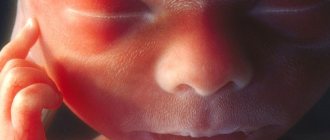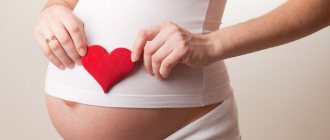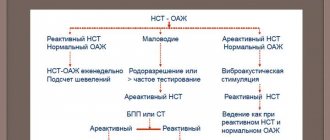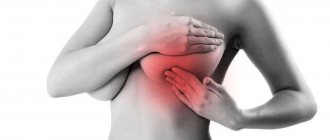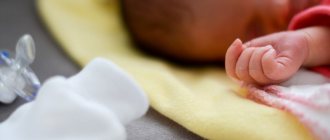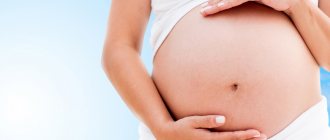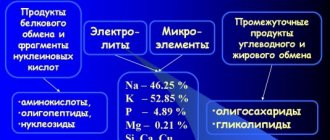Features of the baby's nutrition in the womb
The small body of the unborn child is connected to the mother’s umbilical cord, and through the placenta, both oxygen and various nutrients are exchanged. Depending on the stage of development, intrauterine nutrition occurs in its own way.
In the first trimester
After the fertilized egg enters the uterus and attaches, it begins to grow rapidly along with the internal contents, which in a short time takes on the shape of the future baby. During this period, the embryo does not need a lot of nutrients; what is supplied by the chorion, a specific fleecy layer, is enough, which will eventually turn into the placenta. In addition to the chorion, the yolk sac provides nutrition to the embryo. It occurs 14 days after conception. And it “feeds” the embryo for up to 6 weeks, until the placenta forms and begins to function. The yolk sac produces special proteins that help the embryo grow. The fetus takes the remaining nutrients from the mother's blood through the chorion. If something goes wrong and the gall sac stops functioning before the placenta is formed, the fetus will not be able to survive.
In the second trimester
At the end of the first trimester, the placenta takes on the role of supplying the necessary substances and removes the waste products of the embryo outside, namely into the mother’s blood. In addition, the placenta produces hormones necessary to preserve the fetus. The process of metabolism between the embryo and the maternal body is complex. It occurs thanks to the umbilical cord. It consists of a vein and two arteries. Through the vein, oxygen and all the necessary nutrients are supplied to the unborn baby, and through the arteries, waste material is returned to the mother - carbon dioxide, urea, creatinine, etc. Afterwards, the mother’s kidneys and liver, as it were, utilize all the waste products of the fetus. Also, by the end of the second trimester, the unborn child already swallows a certain amount of amniotic fluid and all the substances it contains help “train” the digestive system. They are not completely eliminated from the body, but are deposited in the intestines and will be passed as meconium after birth.
Reef manta embryos actively work in the womb to obtain oxygen.
Reef manta rays ( Manta alfredi
), with their mouths wide open, they swim slowly and absorb water along with plankton, providing themselves with food and oxygen. Image from shark-references.com
How do non-placental vertebrate embryos breathe in the womb? Japanese biologists conducted an ultrasound examination of the fetus of a reef manta ray, one of the largest rays. The reef manta has neither a placenta nor an umbilical cord through which the fetus can breathe. It turned out that the embryo actively and regularly swallows amniotic fluid by mouth, just as embryos do in eggs in oviparous vertebrates.
In many viviparous vertebrates, the embryo developing in the mother's uterus receives nutrients and oxygen through the placenta. Such animals include not only placental mammals, but also, for example, some sharks, which demonstrate an excellent example of convergent evolution. At the same time, in many other viviparous vertebrates (fish, amphibians and reptiles) the placenta is completely absent. How in these cases is the problem of providing the developing embryo with oxygen solved?
Japanese biologists have studied the respiration mechanism in the embryo of the reef manta Manta alfredi
, one of the largest representatives of stingrays.
The reef manta lives in the tropical zone of the Indian and Pacific oceans and, unlike another species, M. birostris
, or giant sea devil, gravitates to shaded coastal habitats. The female manta bears a single calf for a very long time (almost a year), which is born very large - weighing almost 10 kg. Until recently, it was believed that the manta embryo grows rapidly thanks to the nutritious and fat-rich “milk” that is released through the wall of the uterus. However, it was completely unknown how the embryo obtains oxygen for itself in the absence of even a hint of an umbilical cord.
The main research was conducted on a pregnant female reef manta ray at Japan's Huraimi Aquarium, Okinawa. This female, 3.78 m in diameter, was caught by Japanese fishermen and transferred to the aquarium. Six months after the research, the female successfully gave birth to a calf (by the way, this was only the second case of a reef manta being born in captivity). In addition, the morphology of nine dead specimens of manta rays of different ages of two species, M. alfredi
and
M. birostris.
According to an ultrasound study performed on a female reef manta, the embryo opened and closed its mouth rhythmically (with a period of 1.7 seconds). The image clearly shows that during the opening of the mouth (expansion phase, Fig. 1 i–ii) the lower jaw dropped, while during closing (compression phase, Fig. 1 iii–iv) the lower jaw rose, and the oral cavity decreased in size. sizes. When the lower jaw began to close, the oral valve, which is located behind the jaws, quickly rose and closed the oral opening.
Rice. 1.
Sequence of respiratory movements of a reef manta embryo as determined by ultrasound analysis (
a
) and 3D reconstruction of specific phases of jaw movement (
b
).
( i
) beginning of mouth opening, maxilla - upper jaw, mandibula - lower jaw, uterine wall - uterine wall;
( ii
) maximum opening of the mandible;
( iii
) closing of the oral valve (maxillary valve) and beginning of closing of the lower jaw;
( iv
) final closure of the mandible.
Drawing from the discussed article in Biology Letters
When the authors compared the morphology of an embryo, a newborn calf and an adult manta ray, they noticed large differences in the structure of the squirters. Squirrels (in English they are called spiracles) are small openings located behind the eyes and are a modified pair of gill slits. The real gill slits of manta rays are located on the ventral side. It is believed that squirts are used by some species of sharks and rays that are bottom-dwelling. Very often these creatures bury their mouths in the sand, so it is not always convenient to swallow water with their mouths, but with sprinklers it is just right. So, in embryos and newborn mantas, the squirts also turned out to be well developed, while in adults the squirts were almost reduced (Fig. 2). Adult mantas have no particular need for them, since they swim in the water column and almost never sit on the bottom.
Rice. 2.
Squirter in a newborn calf (
a
) and in an adult reef manta (
b
).
In a newborn, the spiraclular valve is visible. ( c
) Changes in squirter size and morphology that occur during manta development;
in newborn M. alfredi
(
white circles
) and
M. birostris
(
black circles
) the squirter opening is oval, whereas in adults they take on a slit-like shape.
Figure from the discussed article in Biology Letters
From this study, the authors conclude that the embryo ingests amniotic fluid, pursuing, in all likelihood, a dual purpose: firstly, it uses it for respiration, and secondly, for nutrition. The respiratory function is indicated by a regular and very frequent rhythm of swallowing, which is difficult to explain in any other way. It is curious that the embryo in the egg in oviparous vertebrates does almost the same thing. In addition, the respiratory function of swallowing is confirmed by the fact that in manta ray embryos not only the oral valve, but also the squirter valves were well developed. In bottom-dwelling sharks and rays, these valves are also well developed: they prevent water from escaping back when closing the jaws and increasing pressure in the oral cavity, thus expelling water through the gill slits. And it is logical to assume that the embryo swallows amniotic fluid for the purpose of nutrition simply because, on the one hand, the fluid is rich in nutrients, and on the other hand, the embryo cannot feed in any other way.
The authors suggest that the described method of embryonic respiration may be common among viviparous rays and sharks. Although some points remain unclear. Firstly, I would like to see with what rhythm the spray valve opens - is it the same rhythm with which the mouth opens and closes? Secondly, it is not very clear why the embryo needs squirters at all. A manta ray embryo in the womb could easily do without them, receiving liquid only through the mouth and breathing safely, as adults do. Perhaps squirts develop in embryos because this is a rather primitive and ancient feature: its localization is determined by skeletal transformations that occurred during the evolution of fish. According to the Haeckel–Müller biogenetic law, every living creature in its individual development repeats the forms passed through by its ancestors. It’s just that in some shark-like fish such a hole turned out to be quite useful even in adulthood.
Source:
Taketeru Tomita, Minoru Toda, Keiichi Ueda, Senzo Uchida, Kazuhiro Nakaya.
Live-bearing manta ray: how the embryo acquires oxygen without placenta and umbilical cord // Biology Letters
. Published online 06/06/2012.
Varvara Vedenina
The influence of mother's diet
When a child is just developing in the first trimester, he still does not distinguish what his mother eats. But in the second trimester, she can already distinguish different tastes well due to the fact that some substances from what the mother eats enter the amniotic fluid. It is clear that the child “loves” sweets more while still in the womb. However, you should not overindulge in sweets. A large amount of sugar puts excessive stress on the pancreas of the mother's body and almost the same on the gland of the unborn child. The same applies to fatty foods; it provokes excess weight not only in the mother, but also in the fetus. The placenta reliably protects the baby from harmful substances, but with a significant dose, for example, alcohol, strong drugs, it begins to quickly lose its functions. He gets older and misses more and more substances that are unnecessary for the child. Coming out of this, a pregnant woman should calculate her diet in such a way that at every meal, the baby receives all the necessary vitamins and microelements. Any lack of nutrients can negatively affect the development and health of the unborn child. It is also important to remember that the baby compensates for the deficiency of certain substances from the mother’s body without her consent. For example, if there is not enough calcium, then soon the future mother’s nails will begin to peel, her hair will fall out, and her teeth will crumble. At the same time, there is no need to eat for two. The baby doesn't need much, even in the third trimester. It is enough for him that his mother eats in moderation. Overeating only harms the health of the mother and pregnancy in general.
Features of fetal nutrition in the first two weeks after conception
The father's sperm have a small supply of nutrients, which they need to maintain their own life for 4-5 days and quickly move through the uterus and tubes. Therefore, at the moment of fertilization, they transfer only genetic information to their unborn child. And the egg, maturing in the mother’s ovary, necessarily accumulates the necessary micro- and macroelements for the future fetus. As a result, after meeting the sperm, it looks like a chicken egg without a shell: inside the nutrient layer called the yolk sac, covered on the outside with a protective membrane, an actively dividing embryo floats. It is thanks to this supply of building and energy material that the fertilized egg exists during the first two weeks after conception, while it drifts in the uterine cavity in search of a place for attachment. If the progress of the embryo slows down and the accumulated substances are not enough, then it dies.
What does a child eat when mom has toxicosis?
This question worries many expectant mothers. There is no reason to worry. Nature has decreed that during the period of toxicosis, and during the normal course of pregnancy it occurs in the first trimester and lasts several weeks, the unborn child is nourished by the gall sac, and takes very little of everything it needs from the blood. It is important to eat little but often during this period. Consume the right foods. Try to maintain a drinking regime. Use all techniques to reduce toxicosis. Another thing is if the vomiting is so severe that it negatively affects the woman’s general condition and weight loss is observed, then you need to seek medical help.
3rd trimester of pregnancy
28 weeks. Weight increases to 1 kg. He already recognizes his mother’s most familiar voice and reacts to it if his mother communicates with him. Talk to your baby, he will already hear everything that is said. At this stage, birth is considered premature.- 32 weeks. Don't worry if you notice that your baby begins to move less. He just doesn't have enough space. Its weight is approximately 2 kg. Research indicates that he may be dreaming about something.
- 34 weeks. The child's weight is slightly more than 2 kg. Most often, at 34 weeks the head is already down. The lungs have fully developed, so that if he goes into labor prematurely, he will breathe without any assistance.
- 35 weeks. Fat accumulates actively on the extremities. Hearing is fully developed. Most often, at the 35th week of pregnancy, expectant mothers find it difficult to breathe. This occurs due to the fact that the fetus is located throughout the uterine cavity.
- 36 weeks. From now on, the baby adds 28 grams every day. It is becoming more and more difficult for my mother to move. He is fully formed.
- 37 weeks. The baby still receives oxygen through the umbilical cord. It weighs about 2800 grams.
- 38 weeks. The fluff that previously covered the baby's skin disappears. Since he breathes liquid, hiccups may occur. The tremors are becoming more intense. On the head, hair can be longer than 2 cm.
- 39-40 weeks. The baby continues to accumulate fat. Height varies from 40 to 60 centimeters.
Just above, the development of a child in the womb was described week by week. But remember that labor can begin as early as 38 weeks, and this is considered normal. Such births are timely. As a rule, at birth the baby weighs from 3 to 4 kg and is about 50 cm tall. As soon as he is born, you will hear the first cry. And your life will change forever!
How to provide your child with the necessary substances
If the mother’s body does not have enough nutrients for the normal development of the unborn baby and a balanced diet cannot solve the problem, then special vitamin complexes that are designed taking into account the needs of both the mother and the fetus will help replenish their supply. The influence of a mother’s diet on the development, health and well-being of the unborn child should not be underestimated. No matter how much you are drawn to unhealthy foods, it is still worth thinking about and trying to select more healthy ones, as well as control the amount of food consumed.
The third stage of child development in the womb: the baby prepares for birth
The third stage of fetal development begins from the seventh month of gestation . At this point, the weight of the fetus reaches approximately 1 kg, its length is 35 cm . The child has already formed all the senses with which he can respond to signals from the surrounding world. The baby begins to hear the voice of his parents . The skin becomes more elastic. Even if a child is born at the age of six months, in most cases doctors have the opportunity to save such a child using resuscitation methods.
Currently reading: First month of pregnancy
Closer to the ninth month of pregnancy, the child’s body weight approaches 2 kg, and his height approaches 40 cm . At this point, the formation of the immune system is nearing completion, and the baby finds a more comfortable position before the upcoming birth. Every day the baby's weight begins to increase rapidly. At the time of birth, the average height of the child is 50 cm, weight is about 3-3.5 kg .
Antiphospholipid syndrome and pregnancy Dostinex during pregnancy Blood pressure during pregnancy Hidden pregnancy Complications of herpes suffered during pregnancy
The first 3 months after conception
After the fertilized egg attaches to the wall of the uterus, the function of supplying the necessary substances is performed by small villi that appear on the fetal membrane. They penetrate the mucous layer of a woman’s uterus. Nutrients from the mother travel through the bloodstream to the villi, and from there to the fetus.
At this stage, the needs of the fetus are not great, but every day the embryo grows and needs more and more “building material”. To provide it with everything it needs, the villi grow over time and intertwine with the mother’s blood vessels.
.
Thus, they form the placenta, which will be the main supplier of nutrients and oxygen for the baby until birth. The final formation of the placenta occurs at 10-12 weeks of pregnancy. Before this, the fetus is very vulnerable, since it has not yet developed a defense system against toxins contained in the mother’s body.
In the first few weeks after fertilization, the process of laying down all the future systems of the baby occurs.
At this stage, he really needs such an element as folic acid. Its deficiency can cause serious disorders of the nervous system. The consequences can be very different - mental disorders, and even miscarriage.
note
, therefore, many gynecologists, even during pregnancy planning, prescribe to their patients a vitamin complex developed taking into account the needs of the baby.
From the 3rd to the 12th week: formation of the placenta, feeding habits of the fetus
This article talks about typical ways to solve your issues, but each case is unique! If you want to find out from me how to solve your particular problem, ask your question. It's fast and free
!
In the third week of the baby’s life, its outer protective shell forms villi - special outgrowths that penetrate deep into the endometrium. This is how the chorion is formed, which until the 6th week of gestation is located around the fertilized egg. The placenta begins to form from it, the formation process lasts until the 12th week.
Chorionic villi ensure fusion with the epithelial layer of the uterine walls. It is accompanied by the plexus of blood vessels of the maternal body and the embryo, through which nutrients flow. At this moment, the embryo is most vulnerable; all the substances that the mother consumes enter its body. You can see what placentation looks like in the photo.
When does the embryo begin to feed from the mother?
Around the 16th day, the embryo reaches the uterus and attaches to its wall. By that time, the reserves in the yolk sac are running out, and the embryo begins to receive nutrition through the chorionic villi, which are about to become the placenta. From now on until the birth of the child, it is both a conductor and a filter for various substances entering the mother’s blood from the outside.
That is, already from the third week of pregnancy, the embryo begins to feed from the mother!
Structure and functions of the placenta
The placenta is multi-layered and consists of lobules filled with vessels. Some of them connect the uterus to the placenta, and the other part, uniting, turns into the umbilical cord, which connects the embryo to the placenta. How a child is fed through the umbilical cord determines his height, weight, and health. If there is not enough something in the mother’s menu for the development of the baby, these substances will come from the woman’s body, depriving her of what she needs.
Along with the barrier, endocrine and respiratory functions, the placenta performs a nutritional function, supplying new life with the necessary substances:
- Proteins and lipids are building materials for living tissues;
- Glucose - it plays a major role in the nutrition of the fetus;
- Fats – for optimal metabolism;
- Vitamins. They accumulate in the placenta and reach the fetus in optimal combinations with other elements;
- Electrolytes and minerals – sodium, potassium, chlorides, calcium, phosphorus, iron;
- Water.
If the mother is physically exhausted, the child’s development may be delayed and the placenta may be disrupted.
Fetal nutrition in the second half of pregnancy
In the last months, the baby in the womb is still fed through the placenta, but the baby already looks like a newborn, the digestive organs are formed, and now the baby is able to swallow amniotic fluid, receiving from it all the required components, including enzymes for their digestion . This is how the preparation begins for the digestion of milk. Depending on what the mother ate, the amniotic fluid may change taste, and the fetus reacts to this with movements.
The placenta can't cope
Ideally, the placenta begins to age and thin when the baby is ready to be born, but sometimes this happens earlier, leading to premature birth or hospitalization for the mother. This process does not always depend on her lifestyle, but knowing how the child eats before birth, she and her environment are obliged to ensure his full development.
Pregnancy. A look from the inside - video
The mother’s role in the baby’s nutrition – what does the baby get from the mother’s diet?
From the moment the placenta is formed and throughout pregnancy, the baby will receive exactly the substances that the mother uses. That’s why it’s so important while expecting a baby
. In addition, the child also receives harmful substances through the blood, such as nitrates, alcohol, etc. This must be remembered when taking medications.
This does not immediately affect the child. A woman’s body is designed in such a way that the unborn baby will, in any case, receive all the necessary substances in the quantities in which he needs them. Even if this happens to the detriment of the mother. If a child does not have enough calcium, it will be excreted from the mother’s body. As a result, she has a high risk of developing dental problems.
The same goes for iron. Hemoglobin is extremely important for a growing organism, as it is part of the blood. This is why most expectant mothers often experience iron deficiency.
It is also worth paying attention to the amount of food eaten
. The widespread stereotype that an expectant mother should feed for two has no basis.
Moreover, this approach to nutrition can lead to the fact that, trying to eat more, a woman will not notice the border between quantity and quality. As a result, a growing baby runs the risk of becoming deficient in essential substances.
How and what does the fetus eat in the womb during the 1st trimester of pregnancy?
Immediately after conception, as soon as the female egg is fertilized, a special membrane is formed around it - the yolk sac. It appears as a result of the union of an egg with a sperm and already contains a small supply of nutrients and microelements. That is, initially the embryo lives off of a small amount of calories that were in the man’s seminal fluid and egg
.
While the fertilized egg moves towards the uterus, this membrane will supply it with all the necessary elements. Typically, the period of time during which the egg reaches the uterus is 10-13 days. If during this time the supply of nutrients in the yolk sac runs out, the fetus will die. From the point of view of natural selection, this is correct, because an initially weak fetus has practically no chance of survival. As a rule, this happens when a woman’s body is not ready to bear and give birth to a child.
Nutrition for pregnant women from 1 to 8 weeks.
If you are planning a pregnancy or are already pregnant, you should think about your baby's future right now. From now on, you will need to carefully monitor everything you do and how you feel, since the child’s health will also depend on this. During pregnancy, you and your baby form a single whole in the literal sense of the word, and everything that enters your body must also reach it. And how you eat throughout the forty weeks of pregnancy will largely determine his well-being, development and health. In addition, according to many studies, the mother’s nutrition can indirectly affect even the child’s life expectancy in the future. Nutrition and its role in pregnancy. Let's try to figure out what happens inside your body throughout pregnancy step by step, outside and inside, and how the fetus develops depending on the intake of certain substances into the mother's body. How will the pregnant woman feel and what feelings will arise, and naturally, we will also discuss questions about how you can provide your own body, and with it the child’s body, with all the necessary nutrients so that the unborn child is healthy and strong. We will focus on the importance of certain nutrients at different stages of fetal development and ways to subsidize these substances to it. It is important, however, to emphasize that the expectant mother’s diet must be balanced and must contain the daily requirement for these vitamins and microelements throughout the long nine months of pregnancy. First trimester. There is some confusion in the counting of the first trimester, in some sources it is the 12th week, in some even the 14th, therefore, we will count the first trimester according to the average scheme from the first to the 13th week of pregnancy. So, let's begin to discuss in detail pregnancy and the features of its course, as well as the connection with nutrition.
The first three weeks of pregnancy. In the period from approximately the 10th to the 16th day from the beginning of the next menstruation, fertilization will occur, and the active process of fragmentation of the zygote and the formation of the embryo begins, as well as its movement through the fallopian tubes to the uterine cavity for implantation. During this period, the embryo is in no way connected with the mother and is fed only by the yolk sac, special reserves of nutrients accumulated by the egg during its maturation. Before conception and in these first weeks of pregnancy, the expectant mother should actively prepare for bearing the baby. You need to categorically exclude alcohol from your diet, quit smoking and visit doctors, especially a gynecologist, therapist and dentist, and, if necessary, other specialists who will help bring your health to the ideal possible. You need to become more attentive to your diet, especially to foods containing vitamins and especially folic acid, which is necessary for the normal development of the embryo. The 4th week of pregnancy is the period of implantation and the beginning of the active development of pregnancy. During this period, a pregnancy test performed at home in a urine test already becomes positive. At the same time, expectant mothers usually feel a surge of energy and strength and an unusual emotional uplift from such news. But on this occasion, you shouldn’t celebrate with alcohol, even if it’s a glass of wine or champagne; it’s better to switch to non-alcoholic drinks. And in this period, nutrition will begin to play key roles in the development of the embryo. A diet rich in folic acid will be especially important now, since this is one of the main vitamins for pregnant women during this period. Its deficiency can lead to provocation of premature birth or defects of the nervous system in the fetus, inhibition of the mental development of the baby. In addition, folic acid can prevent the development of anemia in mother and child, as it helps in normal hematopoiesis and improves the condition of the skin and mucous membranes. It is for these reasons that the diet of pregnant women from an early stage must include meat and fish, dairy products, fresh fruits and vegetables. And although folic acid is partially lost during heat treatment, more of it is retained in dairy and meat products. 5th week of pregnancy. The embryo is already nourished by the mother’s body, developing in the thickness of the uterine wall. From this period for the next couple of months, he will be especially sensitive to the effects of negative factors, including those from nutrition. At this time, the formation of the liver, heart, thyroid and pancreas, the hematopoietic system will occur, and the respiratory tract will also form. The embryo reaches 2.5 mm in height and begins to form a nervous system in the form of a rudiment of the neural tube. The mother’s body also undergoes changes due to the ever-increasing level of pregnancy hormones; the condition may worsen, toxicosis manifests itself in the form of morning sickness, vomiting, drowsiness and frequent urination. This is due to the action of progesterone in the corpus luteum of the ovary at the site of the released egg. Toxicosis can accompany a pregnant woman before the fetal placenta is formed.
During this period, it will be difficult to follow a diet, since the body may resist taking even the most favorite and familiar foods, as nausea and dizziness occur. During this period, there may be a need for salty or spicy foods, exotic requests - if you like it, they can be satisfied, but in moderation. The body itself now tells you what you need to alleviate the condition. It is now recommended to eat light foods, eat small and little meals, in the morning, without getting out of bed, you can eat an apple or yogurt to make it easier. The 6th week of pregnancy is a period of active formation of the bone marrow with the spleen, stomach and colon, trachea and larynx, lungs, pituitary gland and inner ear. In the embryo, it is already possible to distinguish the rudiments of the limbs, which it can even move, and also turns its head, the fetal thymus gland is formed, which is responsible for the immune response, the baby reaches a length of 6 mm. The placenta is actively developing, which in the future, as it forms, will nourish and protect the fetus and produce hormones for its normal development. By the time it is fully formed, toxicosis will also recede. The little man is forming and now he really needs building material from his mother’s body. Among other things, calcium and phosphorus are especially important, and they are found in the most optimal ratios in milk and dairy products. Seventh and eighth weeks. In the seventh week, the formation of the brain, the small intestine of the adrenal glands occurs, and the first motor and reflex primitive reactions appear; the embryo reaches 9 mm in length. A woman’s breast areolas begin to darken, and some mothers only recently find out about their pregnancy. It is important to take care of yourself immediately and fully. By the eighth week, the child has grown to 11 mm, bones and joints are developing, almost all the main organs are formed, but they are actively developing and growing, the outer ear and eyeballs have formed, and the upper lip is forming. More and more, the embryo begins to resemble a person. The expectant mother usually registers at this time or at least visits a doctor, she undergoes tests and actively fights toxicosis and general malaise. But, despite feeling unwell, you need to eat in such a way as not to deprive the fetus and your body of building materials and necessary substances. During this period, proper nutrition is more important than ever for pregnant women, and during this period they simply cannot do without milk and dairy products. Dairy products provide not only calcium and phosphorus, which are so necessary for the growth and development of the baby, but also folic acid, B vitamins, vitamin E, complete animal protein, vitamin A and D, phosphorus, and animal fat. And besides, it is in dairy products that the ratio of calcium to phosphorus will be in ideal proportions for absorption, which will allow the fetus to receive them in full quantities. If a woman for some reason does not consume whole milk (due to indigestion and deficiency of enzymes for its absorption), fermented milk products can be used - kefir, yogurt, cottage cheese. Also, do not forget about fresh vegetables and fruits, which are needed daily, and complete proteins, mostly of animal origin. You also need to drink enough fluids, since toxicosis causes loss of fluid through vomiting and loss of salts. Tomorrow we will continue the topic. More articles on the topic “Nutrition for pregnant and lactating women”: Fish in the diet of nursing mothers. Do nursing mothers need vegetables? Bread, pastries, pancakes in nursing nutrition Nursing nutrition - we feast on seeds and nuts Various sauces in nursing nutrition Nutrition for a nursing mother - sweets Breastfeeding and spices, herbs, spices Healthy nutrition for women, nursing and not only Healthy nutrition for mothers. Continued The first days after childbirth. Nutrition Nutrition for pregnant women from 9 to 13 weeks. Nutrition for pregnant women from the 14th to the 20th week. Nutrition in the second half of pregnancy. What is not recommended for pregnant women? What should pregnant women be careful about in their diet? Why do you need calcium during pregnancy? What you need to know about nutrition during pregnancy? Features of constructing a diet for pregnant women Slow eating and its health benefits “Calorie blockers” - will they help you lose weight? Vitamin-protein diet: can mothers have it? Are sunflower seeds healthy or harmful? Diet to gain weight Breathing exercises for weight loss Does green tea make you lose weight? Sugar or its substitutes: which is more dangerous? How to find a nutritionist and why do you need one? How to determine your ideal weight? How to normalize intestinal function? How can a mother lose weight during breastfeeding? How to lose weight without giving up food? How to choose the right diet for mothers? Does a woman need to cleanse her body? Is it possible to reduce the calorie content of dishes? How to maintain weight after losing weight? Who needs to take extra vitamins? How to eat well while losing weight? How to gradually remove fat from the sides by summer? How to eat meat correctly: how much do you need for health? For whom are diets prohibited? Types of nuts and their benefits for the body Benefits of ginger for the health of children and adults Lack of protein in the diet and body Are porridges made from pearl barley and barley healthy? What is obesity, why is it dangerous? Healthy and unhealthy foods: how to choose them? Broccoli: health benefits and weight loss Benefits of plums for women's health Benefits and harms of genetically modified foods What are the benefits of seaweed Benefits of cucumber juice for pregnant and lactating women What are the dangers of quick weight loss methods? How to eat with a sedentary lifestyle Features of nutrition when playing sports What to eat for breakfast for health and slimness? The Presidents' Diet: how to lose weight correctly Products that cleanse the liver Weight loss dinners and their recipes Who benefits from fish oil? Beauty vitamin, which one is the most important? Nutrition according to Galina Shatalova's system Sweets that do not harm the mother's figure Weight loss of stars for ordinary mothers Cheese diets: aren't they dangerous for women?
How to provide your baby with everything he needs?
From the moment of conception until birth, the child takes the substances necessary for growth and development from the mother’s body. Everything that enters the mother’s blood, be it food processed during the digestion process, medicines, alcohol or drugs, also enters the fetal body. You need to especially carefully monitor your lifestyle in the first weeks of gestation, when there is no placental barrier yet and all elements go directly to the embryo.
Diet of a pregnant woman
A pregnant woman's diet should be rich in nutrients. She needs to consume a sufficient amount of proteins, fats and carbohydrates; diets for weight loss during gestation are unacceptable.
The diet must include the following products:
- lean meat and fish;
- vegetables and fruits;
- cereals;
- dairy products.
Not all foods are healthy during pregnancy. Fatty, fried, salty foods should be excluded from the diet. You should be careful with foods that cause excess gas (apples, cabbage, beans). If a woman is prone to weight gain, she should limit her consumption of bananas, dates, and grapes. Citrus fruits, berries, and chocolate can be strong allergens.
Vitamins and microelements not supplied with food
Not all vitamins and microelements can be obtained from food in sufficient quantities. During pregnancy, a woman needs an increased amount of vitamins and microelements. She need:
- 30% more iodine, vitamins B6 and B12;
- 1.5 times more calcium;
- twice as much folic acid;
- 2 times more iron.
Walking and exercise
For the normal course of gestation, proper nutrition is not enough; the woman’s lifestyle as a whole is important. Walking in the fresh air, gymnastics for pregnant women, yoga help strengthen the body and saturate it with oxygen. Moderate physical activity is necessary for:
- strengthening the musculoskeletal system;
- increasing oxygen levels in the blood;
- improving the functioning of the cardiovascular system and, as a result, the transport of nutrients to the embryo;
- normalization of the emotional state of the expectant mother.
In the womb, the baby is completely dependent on its mother. The fetus receives the same food as she does, and is affected by the harmful effects of alcohol and stress. That is why a pregnant woman should pay maximum attention to her lifestyle in order to ensure the normal development of her child.
(
2
rated
4.50
out of
5
)
From the very first day, the fertilized egg, which will later become the baby, continuously grows and develops. To do this, it needs a variety of nutrients and oxygen. How does a developing organism, without a direct connection with the external environment, obtain proteins, fats and carbohydrates? How does this invisible process of transferring necessary substances from mother to child occur?
What food and substances should the baby receive in the womb?
Basic rules of nutrition during pregnancy: in the first half, you can eat what you want, try not to limit yourself, but also not to overexert yourself with heavy food. Rational meals 4 times a day are the main recommendation. But then you will have to adhere to some features in order to give the child everything he needs through food, and also not harm him.
Second half of pregnancy: During this period, internal organs begin to develop, so they should not be overstrained. For example, kidneys, for them a large amount of animal protein (meat, poultry, fish) is harmful. For this reason, and for a number of other features, it is better to limit the use of these products. You can eat dishes with meat, fish and poultry, a maximum of 2 times a week. Despite the desire to eat something like this, it is better not to give your baby a reason to feel bad. It is better to eat more cereals and vegetables, fruits, sour cream and milk, kefir and cottage cheese. The child will receive all the necessary substances for the proper growth of organs, vitamins and elements that are contained in various cereals, milk and cottage cheese, as well as fruits, potatoes, etc., will help the fetus develop and turn into a small person.
You need to know not only how food is supplied to the baby in the womb, but also that he needs to receive a sufficient amount of carbohydrates so that both the baby and the mother feel active and not lethargic. So feel free to eat the right carbohydrates, in the form of cereals, fruits, and vegetables. Of course, you can indulge in sweets if you want, but if you are overweight, fast carbohydrates should be limited, since severe (more than 15 kilograms) excess weight is not the norm.
Placenta as a source of nutrition
From the 14th week, the fetus switches to placental nutrition. The placenta is a whole network of blood vessels that connect the bloodstream of mother and child via the umbilical cord. Microelements, vitamins, and oxygen reach the baby through the umbilical cord.
The food eaten by the mother enters the stomach, then breaks down into molecules and enters the bloodstream. From there, nutrients reach the fetus through the umbilical cord. In addition, the placenta performs a barrier function, delaying the entry of viruses and toxins into the baby’s body. The outer lining of the placenta prevents the blood of the mother and fetus from mixing.
It's not just food and oxygen that passes from mother to baby. Through the umbilical cord, the baby regularly receives hormones produced by the mother's body. This means that along with food the child receives his first portions of emotions - joy, excitement, fear.
Like all growing organisms, the fetus needs not only the supply of energy resources, but also to get rid of waste products. This also happens with the help of the umbilical cord.
The fact is that the umbilical cord consists of several vessels:
- Vein – which supplies substances from mother to child.
- Two arteries – through which the reverse process occurs.
The constant flow of blood through the umbilical cord makes it extremely elastic and does not allow it to bend. Therefore, cases of umbilical cord entanglement are extremely rare.
At the 6th month of pregnancy, the fetus develops an excretory system, which means it secretes urine into the amniotic fluid. However, this is not as scary as it seems at first glance - the amniotic fluid is constantly renewed. This happens at least 10 times during the day.
At 12-15 weeks, the fetus is able to reflexively swallow amniotic fluid. This is a very important and necessary skill. By swallowing amniotic fluid, he prepares his digestive system to work independently. In late pregnancy, the fetus swallows about a liter of amniotic fluid per day. Even though amniotic fluid contains proteins, hormones, water and nutrients, the baby is still fed by the placenta.
Today, scientists have come to the conclusion that the baby, while in the womb, distinguishes the taste of amniotic fluid, which has a very strong influence on its future taste habits.
How the baby gets the necessary substances in the womb
From the beginning of pregnancy, mothers have been interested in the question of how food is supplied to the baby in the womb. Since at the beginning of the period, many women simply cannot look at food, absolutely any food, or vice versa - absorb only a certain product or a combination of them.
So, before the belly-dweller turns into a fetus, it goes from an egg to a formed organism. Two weeks after fertilization has occurred, the egg is nourished by the yolk sac (the thickened inner wall of the egg).
Then, after two weeks, the egg settles in the wall of the uterus and becomes an embryo, this is a small child who needs good nutrition, as well as oxygen, vitamins, fats and proteins, and, of course, carbohydrates. The delivery of useful substances to the baby will be carried out thanks to the chorionic villi. In turn, they form the placenta, which will serve as a transmitter of all necessary substances from the mother.
Now we know how food comes to a baby in the womb, but it’s worth remembering, and this is important! If the mother does not follow a nutritious diet and does not have enough substances that are necessary for the normal growth and development of the fetus, the embryo begins to feed on reserves in her body. All vitamins and elements, proteins, carbohydrates and fats accumulated in a woman’s body will be transferred to the baby. This is fraught with serious consequences, deterioration of health, decreased immunity, brittle bones, including crumbling of teeth, and so on.
